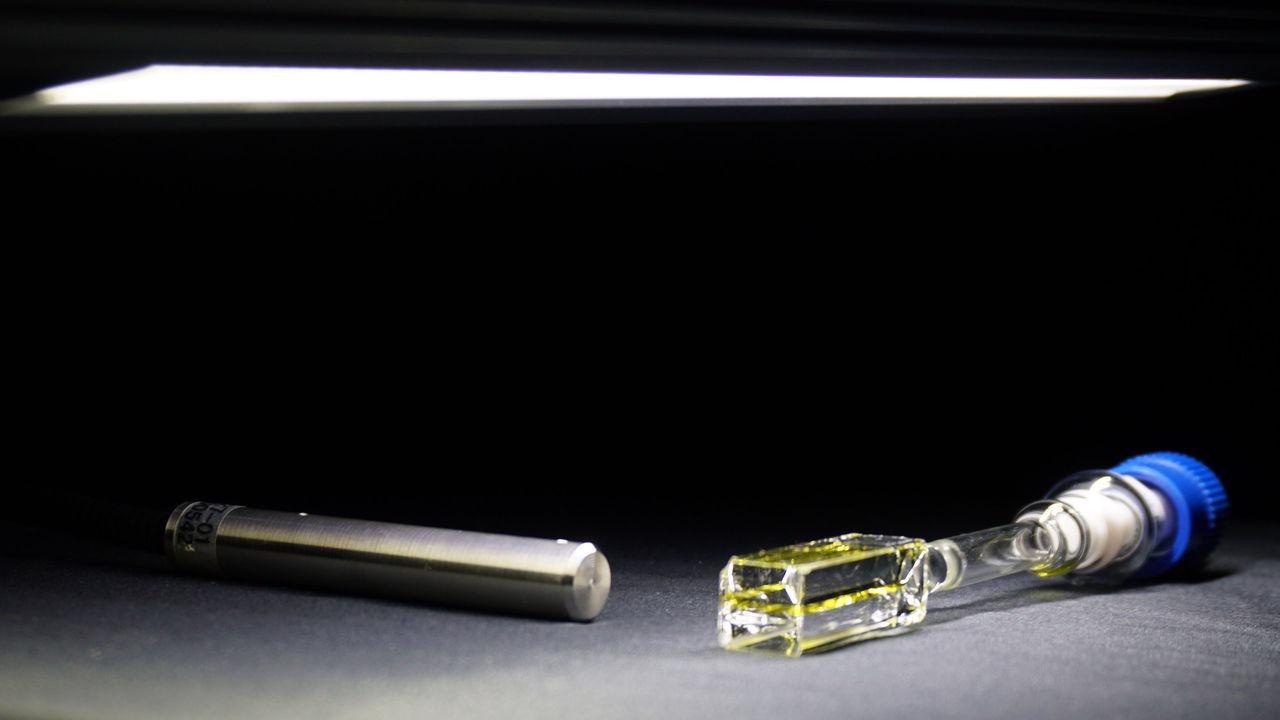Dec 7 2020
A new material system with the ability to directly transform visible light into ultraviolet light with an efficiency twice that of previous figures could boost the performance of light-driven processes ranging from hydrogen production to air purification under ambient light.
 The molecular system in the glass tube on the right efficiently upconverts visible light even from typical LEDs into ultraviolet light through triplet-triplet annihilation. Image Credit: Kyushu University.
The molecular system in the glass tube on the right efficiently upconverts visible light even from typical LEDs into ultraviolet light through triplet-triplet annihilation. Image Credit: Kyushu University.
At Kyushu University, researchers have developed a system that realizes a light upconversion efficiency of 20% at high intensities and retains comparatively high performance even under weak light, which renders it propitious to trap visible light already around humans to power applications that need high-energy ultraviolet light.
People usually try to avoid ultraviolet light due to the damage it can cause to the skin, but Nobuhiro Yanai, associate professor at Kyushu University’s Department of Chemistry and Biochemistry, has been seeking methods to boost the number of such high-energy rays to power photocatalysts that allow a range of beneficial reactions from generating hydrogen for fuel-cell vehicles to purifying indoor settings.
Although dedicated light sources such as ultraviolet LEDs can be used to drive these reactions, they consume energy and increase complexity. Instead, a much more elegant solution is to harvest the sunlight and indoor ambient light that is already all around us.
Nobuhiro Yanai, Associate Professor, Department of Chemistry and Biochemistry, Kyushu University
But such ambient light sources normally have a huge portion of their energy in the lower energy visible region and just a fraction of it in the ultraviolet. Hence, scientists have been looking for ways to directly transform visible light with wavelengths greater than 400 nm into ultraviolet light of higher energy.
To achieve this, the team of researchers headed by Yanai and Nobuo Kimizuka has been paying attention to a process known as triplet-triplet annihilation. This process involves forming energetic states called triplets on molecules after absorption of visible light.
Then, these “donor” molecules donate their triplets to “acceptor” molecules that can merge two triplets to make a single, higher-energy state that is discharged as ultraviolet light.
To date, the highest noted efficiency of traditional upconversion from visible to ultraviolet light by using triplet-triplet annihilation was around 10% and could only be realized with visible light that is 1,000 times more intense compared to sunlight.
Currently, Yanai and his team have reported in the Angewandte Chemie International Edition journal that they have beaten this record while also realizing highly improved efficiencies under weak visible light from the sun as well as indoor LEDs.
We have been trying to improve the efficiency of this process for more than five years, but we had been stuck at around 5%. We finally were able to make a major leap through a new molecular design, which gave us the right molecules for excellent performance.
Nobuhiro Yanai, Associate Professor, Department of Chemistry and Biochemistry, Kyushu University
The two main problems restricting the performance of LEDs are the poor efficiency of triplet-triplet annihilation by the ultraviolet-emitting acceptor molecules and suppression of the produced ultraviolet emission by the triplet-creating donor molecules.
To address such issues, the team developed an innovative acceptor molecule, a so-called TIPS-naphthalene, with a high triplet-triplet annihilation efficiency and sufficiently low triplet energy to accept triplets in a simple way from a molecule known as Ir(C6)2(acac), an exceptional donor that was earlier discovered by the researchers and does not strongly absorb the upconverted UV emission.
The blend of TIPS-naphthalene and Ir(C6)2(acac) was successful in realizing the highest upconversion efficiency of 20.5% under high-intensity light.
Moreover, the system was successful in considerably decreasing the intensity of the excitation light needed compared to traditional systems, thus realizing upconversion efficiencies of around 10% even at intensities analogous to those of sunlight.
This system can efficiently convert very low-intensity visible light to ultraviolet light. I was very surprised that we were able to obtain ultraviolet light even with the LEDs that I usually use at my office desk.
Nobuhiro Yanai, Associate Professor, Department of Chemistry and Biochemistry, Kyushu University
The team attributes this performance to stiff bonding of the TIPS groups to the naphthalene center of the acceptor molecule, which helps inhibit internal molecular movement that results in energy losses and the TIPS groups tweaking the triplet energy of the molecule by themselves while retaining the emission in the ultraviolet region.
Besides finding methods to continue to enhance efficiency, the team is also examining how to make the system perform just as well out of solution to streamline its application further to a range of light-powered processes.
Journal Reference
Harada, N., et al. (2020) Discovery of Key TIPS-Naphthalene for Efficient Visible-to-UV Photon Upconversion under Sunlight and Room Light. Angewandte Chemie International Edition. doi.org/10.1002/anie.202012419.